How to Design a Vegetable Garden Layout in Any Space, Big or Small
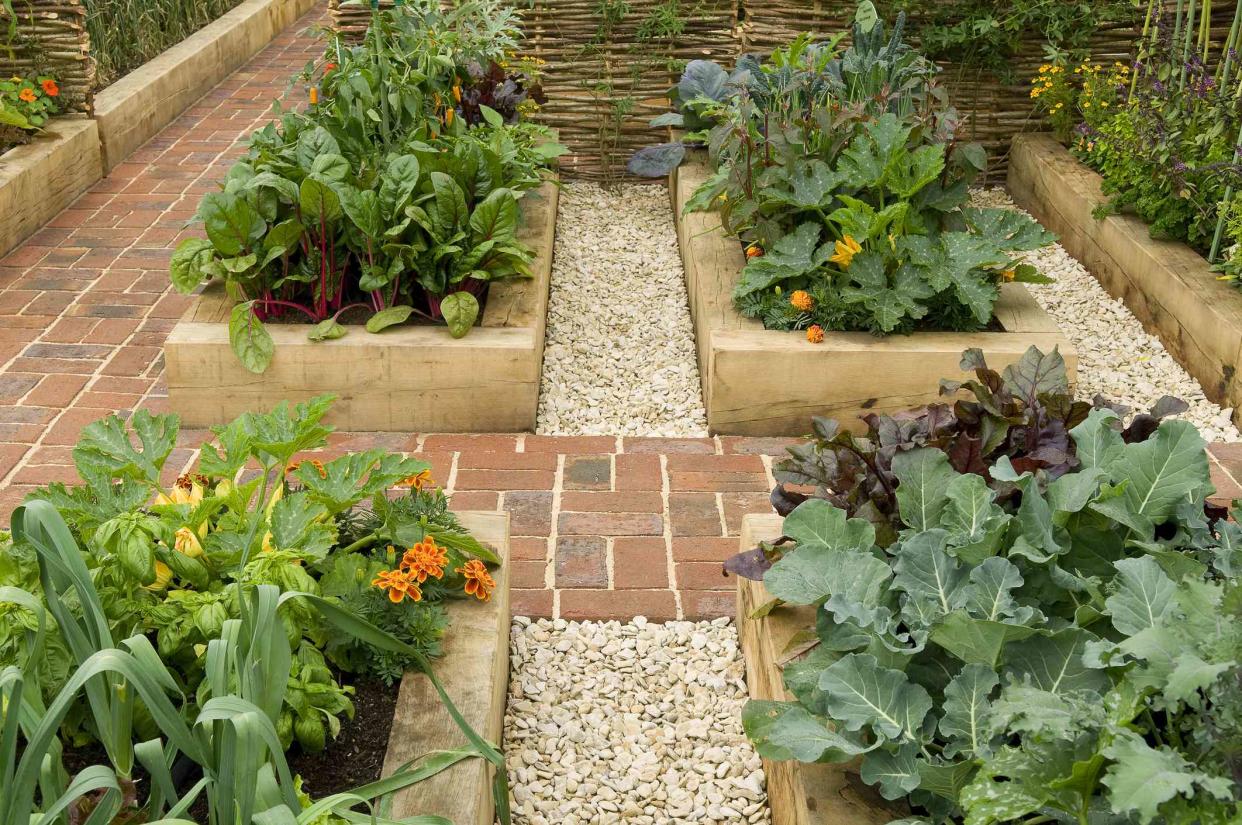
Getty Images / David Burton
Whether you have a large or tiny space, you can design a vegetable garden to grow fresh produce. There are many different layouts for vegetable gardens, from vertical gardening to raised beds to square-foot gardens.
If you are new to gardening, start with tomatoes, lettuce, peas, and radishes that are easy to grow. Take a look at these eight vegetable garden designs to find the best fit for your space.
Vegetable Garden Design Basics
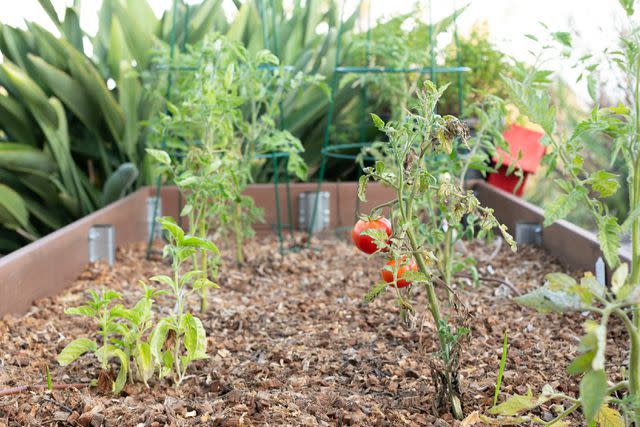
The Spruce / Alandra Chavarria
Just as when you select any real estate, location is the first consideration for a vegetable garden design. Then, you can make decisions on the best size and type of garden for you.
Location: Most vegetables require full sun to produce healthy fruit. Find a location where will the plants receive full sun (6-8 hours) daily near a water source with good drainage. You will have healthier plants if irrigation is easy to provide and the plants have a spot with good drainage.
Soil Type: Vegetables need plenty of water but don't like soggy roots. If you plan to plant directly in the ground, what type of soil is in your yard? Will you need to heavily amend the soil in the garden before you can plant?
Size: Consider your available space outdoors, the types and how many vegetables you want to grow, and the size of your family. Once you make a decision, use graph paper to draw the garden plot to scale to be sure you have enough space for what you want to grow.
Type of Garden: If you have a rocky yard or soil that will require hard work to till and amend so it is healthy enough to grow vegetables, you should consider growing vegetables in raised beds or containers. Raised beds can be large or small and are easier to plant and maintain. Container gardening is perfect for small yards, patios, and balconies.
Vegetable Garden Layouts
These layout options are perfect for any size yard, big or small.
Raised Garden Beds
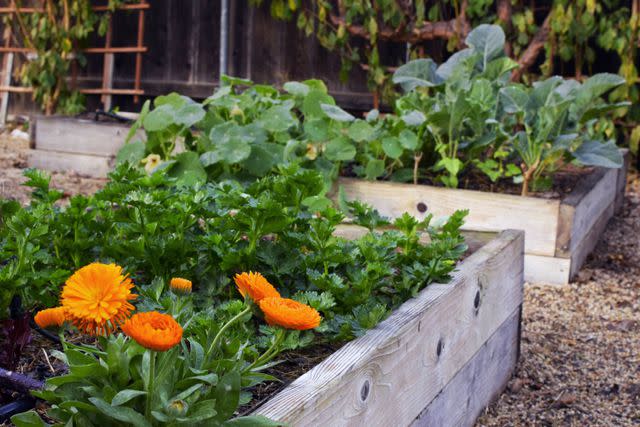
The Spruce / Randi Rhoades
Whether made from wood, metal, or plastic, a raised garden bed frame sits on top of the ground and is filled with gardening soil. If you live in an area with rocky, poor soil or one that has excessive rainfall and poor drainage, then a raised bed is a perfect growing environment.
They are also beneficial in areas with a short growing season because the soil in the bed will warm more quickly in the spring making it perfect for strawberries, lettuces, and peas.
The beds are easy to weed, especially for those who have limited mobility, and root vegetables are easy to harvest because the soil is never compacted by walking on it.
Square Foot Gardens
A square-foot garden takes a raised bed one step further and divides the bed into squares so individual crops can be planted in a small space. The squares can also be built separately as 12 x 12" containers with mulched walkways in between so you can reach each growing area.
While any type of vegetable can be planted in a square-foot garden, it is better to choose varieties that don't grow exceptionally large or spread.
Choose fingerling potatoes over russets or cherry tomatoes over larger beefsteak varieties. Lettuces and herbs are great choices for the square-foot garden because they can be harvested young and replanted often during the growing season.
Vertical Gardens
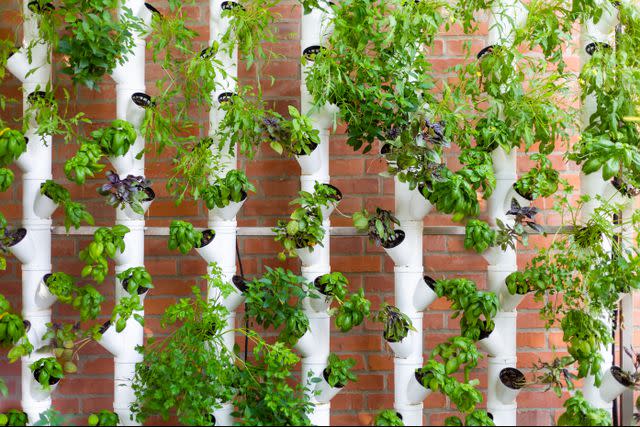
Getty Images/Natalia SERDYUK
A vertical garden is perfect for small spaces and is usually less expensive to develop than other types of gardens. They are easy to access and replant as crops mature.
The structure can be homemade from landscape fabric or wood, or a commercial (usually plastic) growing tower. The garden does require adequate sunlight and good soil for the vegetables. The downside to a vertical garden is that it requires frequent watering, often twice a day.
The best vegetables to plant in a vertical garden are compact varieties like salad greens, baby kale, dwarf peas, bush beans, and herbs. These plants have shallow root systems and mature quickly.
Four-Square Gardens
A four-square garden is made up of four raised beds with paths in between. Early English cottage gardens were commonly divided into four rectangular plots by two intersecting paths—coining the term "four-square."
The beds can be customized to fit your space and are perfect for growing a variety of vegetables while providing access to each one. The beds do not have to be very high off the ground just 6 to 8 inches can be deep enough.
Some gardeners add a fruit tree or trellised vine in the center of each raised bed and add vegetables each season. The vegetables can be planted in designs like diamond patterns with herbs spilling along the edges.
Gardening in Rows
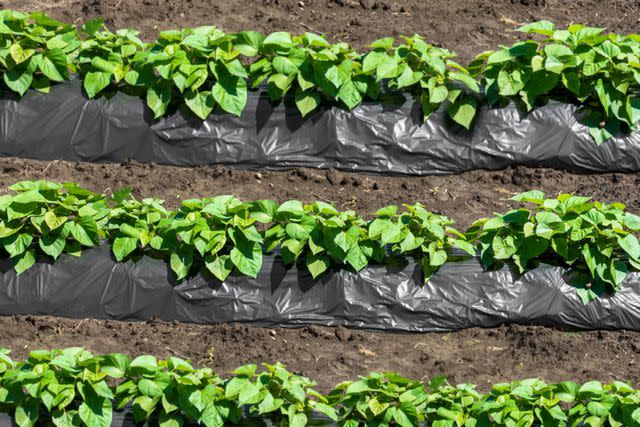
Treehugger / David Karoki
A garden with rows can easily be placed in a small backyard. The ground should be tilled so the soil is loose when you pick it up in your hand.
The best time to prepare the ground and add supplements to the soil for a row garden is in the fall but should be at least three weeks before you plan to plant in the spring. For a small row garden, choose especially productive plants such as snap beans, tomatoes, radishes, lettuce, turnips, onions, greens, carrots, and peppers.
Growing Tip
Consider staking or caging plants to save space, reduce disease and insect problems, and make harvesting easier.
Homestead Gardens
If you have a large family or enjoy preserving food by canning, freezing, or drying produce a homestead garden or a large in-ground garden is ideal. Most homestead gardens are at least one-quarter acre with many covering up to an acre of land.
The rules are the same as row gardening: provide good soil, select highly productive vegetable cultivars, control weeds, plant in a location with full sun, and provide consistent moisture.
If you are planning a large vegetable garden, several tools and systems will make the work easier and more productive. A gas-powered tiller will break up the soil and can even be used to help keep weeds under control after plants are in place. A drip irrigation system will keep plant roots moist but keep water off of the leaves and fruit helping to prevent plant diseases and rot.
Small In-Ground Gardens
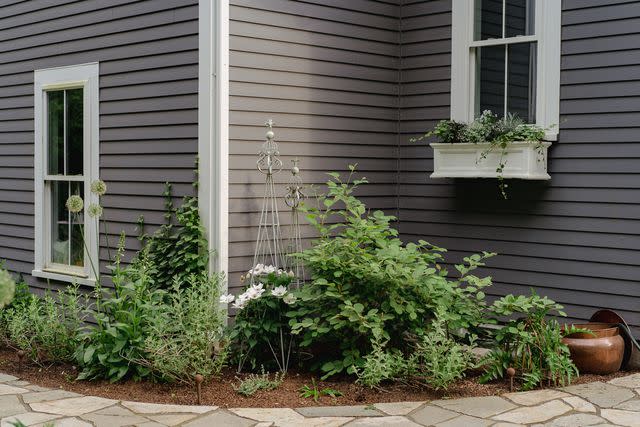
In just a 10 x 10-foot sunny spot, you can easily grow plenty of vegetables for a small family. Start with good soil and follow the tips for row gardening. What you plant depends on what you enjoy whether it is leafy greens or root crops. You can grow more by doing spring and fall plantings. Here's an example of what you can grow during the summer season:
3 trellised or caged indeterminate tomato plants or two indeterminate tomatoes and one cucumber plant
4 eggplants
5 pepper plants
12 bush bean plants
Partial Shade Gardens
If you don't have a spot with full sun, some vegetables will thrive in partial shade whether planted in the ground, a raised bed, or a container. Leafy vegetables, such as leaf lettuce, spinach, collards, Swiss chard, and kale, can be successfully grown in areas that receive 3 to 4 hours of sun. Radishes, kohlrabi, beets, cabbage, cauliflower, and broccoli can also be grown in partial shade.
Choosing Plants for Vegetable Gardens
The vegetable seedlings you select to purchase or start from seed will help determine the design of your garden. Begin your planning with what types of vegetables your family will enjoy eating, your climate and length of growing season, and the size of the mature vegetable plants.
For instance, growing corn takes lots of space, most tomato varieties produce large, sprawling plants similar in size to melon plants. Some types of beans and peas need to be staked to keep the vegetables off the soil and disease-free.
It's a good idea to consider companion planting when space is limited to give different vegetables optimum growing conditions. Tomatoes pair well with basil and other herbs as well as carrots, cucumbers, and squash as part of a three-way companion partnership.
Growing Tip
If you choose to plant in containers, remember the plants will still need the same growing environments as they would when planted in the ground.
Vegetable Garden Design Tips
When you're ready to design your vegetable garden, these tips will help guarantee a successful harvest no matter which design you choose.
Consult your local Cooperative Extension Service office for information on planting schedules and vegetable plant selections for your growing area.
Do not overcrowd plants. They look small as seedlings but planting vegetables too close together will lead to disease and lower yields.
For a good harvest, start with good soil. The soil should be loose and filled with organic matter.
Rotate crops from year to year to help prevent disease and nutrient depletion.
Mulch the garden to help reduce weeds that compete for moisture.
Control pests and diseases by selecting resistant varieties and learning a beneficial insect from one that is harmful.
Frequently Asked Questions
What vegetables should not be planted next to each other?
Planting certain vegetables together has adverse effects on the plants. Incompatible vegetables can stunt growth, invite pests and diseases, and negatively impact flavor. Never grow the following vegetables together: No corn or cabbage next to tomatoes; no eggplants or cucumbers next to potatoes, and no peppers next to cabbage.
Should I plant my garden rows east-to-west or north-to-south?
Garden rows should be planted north-to-south to optimize the plants' exposure to sunlight.
What is the most efficient vegetable garden design?
Square foot gardening is the most efficient vegetable garden design for small spaces.
Read the original article on The Spruce.

